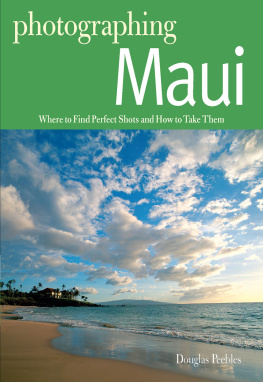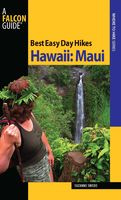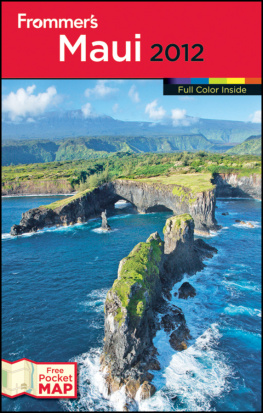photographing Maui
Where to Find Perfect Shots and How to Take Them
Douglas Peebles

Sunset in Kihei

To my wife, Margaret, who is still trying
to figure out when to go with me and
when to send me out on my own.
Copyright 2011 by Douglas Peebles
All rights reserved. No part of this book may be reproduced in any form or by any electronic or mechanical means including information storage and retrieval systems without permission in writing from the publisher, except by a reviewer, who may quote brief passages.
Maps by Paul Woodward, The Countryman Press
Photographing Maui
ISBN: 978-1-58157-893-5
Published by The Countryman Press,
P.O. Box 748, Woodstock, VT 05091
Distributed by W. W. Norton & Company, Inc.,
500 Fifth Avenue, New York, NY 10110

Lahaina
Acknowledgments
I came to Hawaii in 1974 and made my first trip to Maui that year. Since then I have been to Maui over 100 times. Many people have helped me along the way. Some whose names I have forgotten and others I am afraid I will forget to mention.
First to thank is Bennet Hymer. I have done several Maui book projects with him over the years and enjoyed every one. I have also had the pleasure of working with Peter Cannon, Ursula Mahoney, Larry Blieberg, Kristen Shelton, Lane Gregory, Jill Supka, Maggie Perkins, Joyce Timpson, Robert Glick, and others I know I am failing to list.
While on Maui I have had the help of many friends and associates. These include Carl Lindquist, Dave Sheetz, Darrell Wong, Chuck Whiteman, Bob Lee, Sheila Donnelly, KeliI Brown, and Bruce (I thought you had the tripod) Nagel.
Finally, I want to thank Kim Grant, who both got me into this project and got me through it.
Contents

Honolua Bay
Introduction
Maui rates at the top among the worlds scenic places. Mountains plunge into a sea edged with black lava rock and spray-crested wild waves. Deep valleys cut into the mountains like the arrangement in a Chinese painting. Sunsets on West and South Maui streak the sky scarlet, hot pink, cool mauve and lavender.
Everyone wants to take home memories of these scenes. Prints or slide shows of palm-fringed Napili Bay, a Lahaina sunset, Hana Road waterfalls, or a Kula protea blossom conjure up the soft air and the breathtaking beauty.
Douglas Peebles, the photographer-writer of this book, is eminently qualified to guide us to Mauis most scenic spots. A Hawaii resident, he has provided photographs for 50 books on the state over the course of more than 25 years. His books explore the islands large scale, including his aerial images for the From the Skies of Paradise series about the Hawaiian Islands. He reveals the hidden corners in books such as the Majesty series on exceptional trees, and Pua Nani on Hawaiian gardens. His distinctive images also appear regularly in national magazines, ads, annual reports, and other publications.
In this guide, the award-winning travel photographer identifies the top scenic spots in each of Mauis five major regions. He gives precise locations, tells you how to get there, and recommends viewpoints for the camera. He offers some professional tips, but the book is aimed at the point-and-shoot casual photographer as well as the person with the digital SLR and a battery of lenses. Sometimes he cautions you where not to go out of respect for local residents or for reasons of safety.
Peebles shares the aesthetics of photographing this unique island. He writes that color, content, and composition guide him. These ideas underlie his choices and advice.
Even Mauis shape, a lopsided figure 8 created by two separate volcanic events, adds interest to landscape photography. Anywhere from West and South Maui youll see other islands, Molokai and Lanai or Kahoolawe and Molokini, which form spectacular silhouettes against the sunsets.
The color spectrum is astonishing. The sea ranges from pale aqua at the shore to deep sapphire at the horizon. The Hana Coast has more shades of green than youll find on a paint chart. Punctuating the green are the red blossoms of the African tulip trees and, if you venture to Haleakalas foothills, the brilliant plumage of the apapane bird.
People leave their mark on this landscape, from the plantation-era board buildings to the missionary churches and, from the more distant past, the massive Piilanihale Heiau near Hana.
Peebles knows all of Mauis richness and opens it up for the visitor. Even if you dont photograph, youll see more for using his book.
Carol Fowler, Author of Great
Destinations Hawaii: Maui

Protea
How to Use This Book
F8 and be there! If you have been into scenic or landscape photography for very long you have probably heard that F8 and be there is the number one rule. Its true. Being at the right place at the right time vastly improves your photographs. Its been said that if you want to be famous for photographing beautiful people then start by photographing beautiful people. It makes it a lot easier.
The trick to photographing beautiful landscapes though is finding the right place at the right time. Thats what this book is about. Maui is an incredible island. It has been voted, over a dozen times, Best Island in the World by the readers of Cond Nast Traveler magazine. Its not hard to find good spots to photograph. The purpose of the book is to help you find the best spots when they are most beautiful. I hope it will make your photography a lot easier.
Maui is not a very large island. Its 729 square miles (Rhode Island is 1,214 square miles). Its 48 miles long and 26 miles across at its widest. You can get anywhere and back in a day. Planning a day for photography would seem simple, but in some ways its not. Because of the irregular shape of the island, the sweep of the bays, and the height of the mountains, the sun is not always where you think it might be. There are some dramatic sunsets that can be seen from the east side of the island. On the south side sometimes the sun does not clear Haleakala till almost 10 A.M .
I have divided the island into five areas: the Hana Coast, West Maui, South Maui, Central Maui, and Haleakala and Upcountry. This does not mean you should do them in any order. Most any day trip will take you through two or three of these regions. All of the locations listed in this book are easy to get to. There are no long hikes or four-wheel-drive vehicles needed. In a few cases there may be some short climbing to get the best angle or view. I will point those out, and discretion and caution are advised.


















